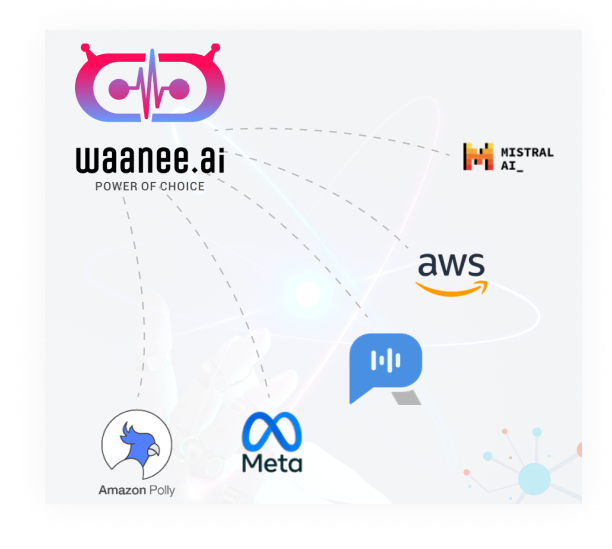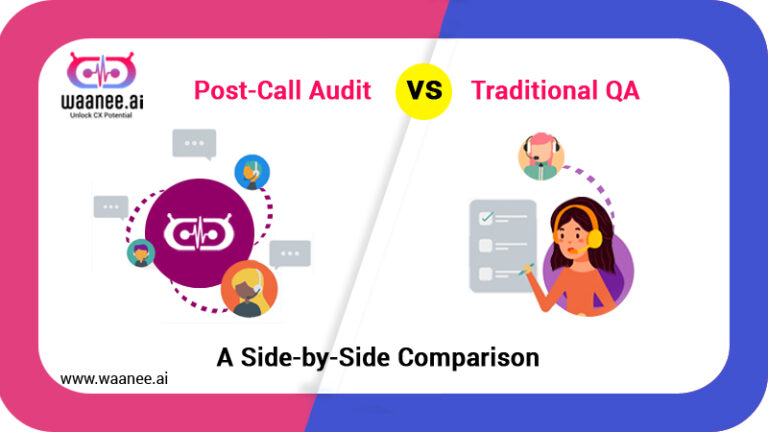
-
Waanee AI Labs
View All »

Get The Latest
Step-by-Step Guide to Migrating from Legacy IVR to Agentic IVR
Read More »How AI-Powered IVR Personalizes Customer Journeys in Real Time
Read More »Why Static IVR Menus No Longer Work in the Age of AI
Read More » - Blog
Post-Call Audit vs. Traditional QA: A Side-by-Side Comparison
Posted by Vishal Vanwari, on 17 Oct, 2025 08:59 AM

The landscape of call center quality assurance is undergoing a dramatic transformation. As customer expectations rise and operational efficiency becomes paramount, contact centers are reevaluating their quality monitoring approaches. The debate between post-call audits and traditional QA methods has never been more relevant, especially as we navigate the QA best practices 2025 landscape.
In this comprehensive guide, we’ll explore both methodologies, examine their strengths and limitations, and help you determine which approach—or combination—best serves your contact center’s needs.
Understanding Traditional QA: The Foundation of Quality Assurance
Traditional call center quality assurance has been the backbone of customer service excellence for decades. This approach typically involves:
- Manual Call Sampling: QA analysts listen to a small percentage (usually 1-3%) of total calls
- Standardized Scorecards: Evaluators rate agents based on predetermined criteria
- Scheduled Reviews: Weekly or monthly QA sessions with feedback loops
- Subjective Evaluation: Human judgment determines compliance and quality scores
The Strengths of Traditional QA
Traditional QA methods have endured because they offer certain advantages:
Human Nuance and Context: Human evaluators can understand complex emotional situations and contextual subtleties that technology might miss. They can recognize when an agent handled an unusual situation with creativity and empathy.
Relationship Building: Regular one-on-one feedback sessions foster stronger relationships between supervisors and agents, creating opportunities for mentoring and professional development.
Customized Feedback: QA specialists can provide detailed, personalized coaching that addresses each agent’s unique strengths and development areas.
The Limitations of Traditional QA
However, traditional call center quality assurance faces significant challenges in modern contact centers:
Limited Coverage: Reviewing only 1-3% of calls means 97-99% of customer interactions go unmonitored, creating blind spots in quality oversight.
Time-Intensive Process: Manual call review is labor-intensive, with each evaluation taking 15-30 minutes. This limits scalability as call volumes increase.
Subjectivity and Bias: Different evaluators may score the same call differently, leading to inconsistent feedback and potential fairness concerns.
Delayed Feedback: The gap between call occurrence and feedback delivery can stretch to weeks, reducing the impact of coaching interventions.
Sampling Bias: Random sampling may miss critical interactions, compliance violations, or emerging patterns that require immediate attention.
Post-Call Analytics: The Modern QA Revolution
Post-call analytics represents a paradigm shift in improving agent performance QA. Powered by artificial intelligence and machine learning, this approach leverages automated QA tools to analyze 100% of customer interactions in real-time.
Key Features of Post-Call Analytics
Comprehensive Coverage: Every single call is analyzed, providing complete visibility into contact center operations and eliminating the guesswork of sampling.
Speech Analytics Integration: Advanced algorithms detect keywords, sentiment, compliance phrases, and conversation patterns across all interactions.
Real-Time Insights: Issues are flagged immediately, enabling rapid intervention before small problems escalate.
Objective Scoring: Consistent, data-driven evaluation removes subjectivity and ensures fair assessment across all agents.
Trend Identification: AI identifies emerging issues, training needs, and customer pain points that manual review might overlook.
The Advantages of Post-Call Analytics
Scalability Without Compromise: As your contact center grows, automated QA tools scale effortlessly without requiring proportional increases in QA staff.
Immediate Coaching Opportunities: Real-time alerts enable managers to provide timely feedback while calls are fresh in agents’ minds, dramatically improving knowledge retention.
Data-Driven Decision Making: Rich analytics inform training programs, process improvements, and resource allocation with unprecedented accuracy.
Enhanced Compliance Monitoring: Automated systems catch every compliance issue, reducing regulatory risks and protecting your organization.
Cost Efficiency: While requiring upfront investment, automation significantly reduces long-term QA operational costs.
Considerations for Post-Call Analytics
Technology Investment: Implementation requires capital investment in software platforms and potential infrastructure upgrades.
Learning Curve: Teams need training to effectively interpret analytics dashboards and translate data into actionable insights.
Human Touch Balance: Over-reliance on automation can depersonalize coaching relationships if not balanced with human interaction.
Side-by-Side Comparison: Which Approach Wins?
Let’s examine how these methodologies stack up across critical dimensions:
Coverage and Sampling
Traditional QA: Reviews 1-3% of calls, leaving significant blind spots in quality monitoring and potential compliance gaps.
Post-Call Analytics: Analyzes 100% of interactions, providing complete operational visibility and catching every critical incident.
Winner: Post-call analytics delivers comprehensive coverage that traditional methods cannot match.
Speed and Efficiency
Traditional QA: Manual review creates delays of days or weeks between call occurrence and feedback delivery.
Post-Call Analytics: Real-time analysis enables immediate identification of issues and coaching opportunities.
Winner: Post-call analytics dramatically accelerates the feedback loop, enhancing learning effectiveness.
Objectivity and Consistency
Traditional QA: Subject to evaluator bias, mood variations, and interpretation differences that can create fairness concerns.
Post-Call Analytics: Applies consistent criteria across all evaluations, ensuring objective and equitable assessment.
Winner: Post-call analytics eliminates human subjectivity, creating fairer evaluation processes.
Depth of Insight
Traditional QA: Provides rich contextual understanding and can recognize nuanced interpersonal dynamics.
Post-Call Analytics: Offers quantitative insights, pattern recognition, and trend analysis at scale but may miss subtle emotional nuances.
Winner: Tie—each approach offers complementary insights that enhance overall understanding.
Cost Considerations
Traditional QA: Lower initial investment but high ongoing labor costs that scale linearly with call volume.
Post-Call Analytics: Higher upfront technology costs but significantly lower ongoing operational expenses.
Winner: Post-call analytics offers superior long-term ROI, especially for high-volume operations.
Agent Development Impact
Traditional QA: Enables personalized mentoring relationships and customized coaching conversations.
Post-Call Analytics: Provides objective performance data and identifies specific skill gaps for targeted training.
Winner: Tie—optimal agent development requires both data-driven insights and human coaching relationships.
QA Best Practices 2025: The Hybrid Approach
Forward-thinking contact centers aren’t choosing between post-call analytics and traditional QA—they’re strategically combining both methodologies to create a hybrid quality assurance framework.
Implementing a Hybrid QA Strategy
100% Automated Monitoring: Deploy automated QA tools to analyze every interaction, flagging high-priority calls for human review.
Targeted Human Review: QA specialists focus on complex situations, coaching opportunities, and calls flagged by AI systems.
Data-Informed Coaching: Use post-call analytics insights to guide personalized coaching sessions, making human review time more impactful.
Continuous Calibration: Regularly validate automated scoring against human judgment to ensure AI accuracy and relevance.
Layered Quality Framework: Combine automated compliance checking with human evaluation of soft skills and customer experience.
Best Practices for Improving Agent Performance QA
Set Clear Performance Expectations: Use analytics data to establish realistic, measurable performance standards that agents understand.
Provide Frequent Feedback: Leverage real-time insights to deliver coaching immediately after calls rather than waiting for scheduled reviews.
Focus on Trending Patterns: Address systemic issues revealed by analytics rather than fixating on individual call failures.
Celebrate Successes: Use data to identify and recognize top performers, sharing best practices across the team.
Empower Self-Improvement: Give agents access to their own performance dashboards, encouraging ownership of professional development.
Balance Metrics with Empathy: Remember that quality metrics should support excellent customer service, not replace human judgment.
Making the Right Choice for Your Contact Center
Selecting the optimal QA approach depends on several factors:
Call Volume: High-volume centers gain maximum benefit from automation, while smaller operations might manage effectively with traditional methods.
Compliance Requirements: Highly regulated industries need 100% monitoring that only automated systems can provide.
Budget Constraints: Consider both immediate costs and long-term ROI when evaluating QA investments.
Organizational Maturity: Assess your team’s readiness to adopt new technologies and analytics-driven processes.
Strategic Goals: Align QA methodology with whether you prioritize comprehensive oversight, cost efficiency, or agent development.
The Future of Call Center Quality Assurance
The evolution of call center quality assurance continues accelerating. Emerging technologies promise even more sophisticated capabilities:
- Predictive Analytics: AI will forecast potential issues before they occur, enabling proactive intervention
- Emotion AI: Advanced sentiment analysis will quantify emotional intelligence and empathy in customer interactions
- Automated Coaching: AI assistants will deliver personalized microlearning content based on individual performance gaps
- Omnichannel Integration: QA systems will seamlessly evaluate quality across voice, chat, email, and social media channels
Organizations that embrace these innovations while maintaining the human elements that make customer service exceptional will lead their industries in customer satisfaction and operational excellence.
Conclusion: Choosing the Right Partner for Your QA Journey
The debate between post-call audits and traditional QA isn’t about choosing one over the other—it’s about finding the right balance that maximizes both efficiency and effectiveness for your unique operation. Modern contact centers need comprehensive coverage that only automation provides, combined with the human insight that builds exceptional agent capability.
As you evaluate QA best practices 2025 for your organization, consider partners who understand this nuanced approach. Waanee AI specializes in intelligent automation solutions that transform call center quality assurance without losing the human touch that makes customer service truly excellent.
Why Choose Waanee AI?
Comprehensive Automation: Waanee AI’s automated QA tools analyze 100% of your interactions, providing complete visibility into contact center performance while reducing QA operational costs by up to 70%.
Actionable Post-Call Analytics: Transform raw data into meaningful insights that drive improving agent performance QA initiatives, with intuitive dashboards that make complex analytics accessible to all stakeholders.
Hybrid QA Framework: Waanee AI doesn’t just replace human judgment—it enhances it by highlighting exactly which calls need human attention and why, making your QA team more effective.
Seamless Implementation: With proven integration capabilities and dedicated support, Waanee AI minimizes disruption during implementation and accelerates time-to-value.
Continuous Innovation: Stay ahead of industry trends with a partner committed to evolving their platform based on emerging call center quality assurance best practices.
The future of quality assurance combines the scalability and objectivity of automation with the empathy and nuance of human expertise. With Waanee AI, you don’t have to compromise—you can have both.
Ready to transform your call center quality assurance program? Discover how Waanee AI can help you implement a hybrid QA strategy that delivers measurable results while elevating agent performance and customer satisfaction.
About The Author
Abhishek Kumar is the visionary CEO of Waanee.ai, a cutting-edge AI platform revolutionizing customer experience through intent-based IVR solutions. An IIT graduate and Indiana University MBA, Abhishek combines deep technical expertise with strategic business acumen. With a proven track record in driving innovation, he has led cross-functional, multicultural teams across geographies, building high-impact solutions in AI, machine learning, and data science. A NASSCOM Gen AI Foundry member and Tata Crucible champion, his specialties include product development, sales force effectiveness, and digital transformation. Abhishek’s passion for deeptech and customer-centric innovation empowers businesses to deliver seamless, intelligent, and scalable CX solutions.
Revolutionize CX
with AI power
Delivers personalized interactions and immediate, data-driven solutions powered by AI, transforming customer experiences.

We use cookies!
We use cookies to ensure that we give you the best experience on our website.
By continuing to use this site, you accept our use of cookies. Learn more
 Recruit Industries Agents
Recruit Industries Agents Build Your Agent
Build Your Agent Improve Self Service
Improve Self Service Employee Experience
Employee Experience Sales and Cross Sales
Sales and Cross Sales Calling Script
Calling Script Integration & APIs
Integration & APIs Auto Summarization
Auto Summarization Conversational Intelligence
Conversational Intelligence Sentiment Analytics
Sentiment Analytics Auto QA
Auto QA Net Promoter Score
Net Promoter Score